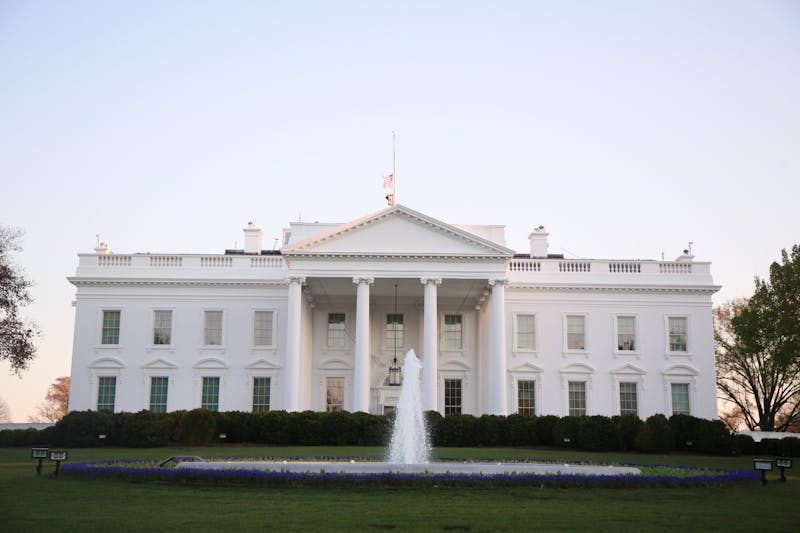
Locust Walk isn't what it used to be. In the last 40 years, partially due to unfortunate events and subsequent protests, fraternities have slowly disappeared from the one-time "frat row."
The era of its creation -- part of Locust Street was closed in October 1964 -- ordained the fate of the walk as a center for protest. The 1960s are historically associated with societal transformation, and one of the issues attracting controversy was the quest of women nationwide for equal rights, fair treatment and freedom from abuse.
Following the initial closing of the 3600 block of Locust Street in 1964, the 3700 block was closed in 1967.
In 1971, "Superblock" was created between 38th and 40th streets, along with the bridge now spanning 38th Street.
The planners' vision -- to create a "backbone of campus" in the form of a pedestrian walkway -- had been realized. However, with Locust Street transformed into Locust Walk, the walkway became a walkable "fraternity row."
Wharton alumnus William English was a member of Alpha Chi Rho and graduated in 1968.
"It was a wonderful experience in those days," he said. But "it was a very different time -- coming from decades, even centuries of male-dominated society."
Another member of the Wharton class of '68, Tom Lamont was a member of Delta Upsilon. He described the 3600 block of Locust as "a one-block bastion of male domination."
Unfortunately, the row and a rising women's movement would prove to be a less-than-harmonious combination -- one that would ultimately result in the placement of the Women's Center in the heart of the Walk.
The Early Movement
The women's movement began in earnest at Penn in 1970. Initially led by a small number of female faculty members, the movement increased drastically in size over the course the next two years. During this period, a series of assaults on women occurred, some classified as rape.
The number of assaults and their increasing frequency led many women to voice the need for new administrative safety measures, with the interests of women specifically in mind.
A particularly volatile incident in 1973 involved the rape of two nursing students.
The explanation provided by the chief of the Philadelphia Police, "If you girls didn't wear those kinds of clothes ...," outraged women on campus.
These tensions culminated in the "Stop Rape" sit-in, beginning April 2 and ending April 6.
Approximately 200 women occupied College Hall during the day, with around 20 staying each night, according to the Almanac.
Helen Davies, currently a professor of Microbiology in the School of Medicine, participated in the sit-in as an untenured faculty member.
"The really big thing for us was getting together and seeing how powerful we were," Davies said.
The protest resulted in the formation of a committee, which drafted "The Plan to Improve Safety for Women at Penn." The plan increased presence and numbers of the University's police force and created the Women's Center.
Davies described the event as "an overwhelming experience. It was an awakening for women all over this campus," she said.
The Women's Center was seen as the major victory of the sit-in. Funded by the University, its mission was to provide workshops, resources and counseling to all Penn students, but it would specifically reach out to Penn women. The center was originally planned to be located in Houston Hall central location.
The 'ATO' Incident
In 1983, an incident at the Alpha Tau Omega fraternity triggered both the growth of the women's movement at Penn and an increased focus in the movement against fraternities.
On the night of Feb. 17, a young woman attending a party at the ATO house ended up in a bedroom upstairs, where several male Penn students allegedly raped her.
While the woman's identity was never revealed, news of the "gang rape" soon spread throughout the school and eventually to the administration.
The University withdrew formal recognition of ATO. However, the gravity of the incident led to a public disaster for the University and a campaign of criticism against fraternities at Penn.
The incident also coincided with the national movement against sexual harassment in the workplace, which was finally banned by the Supreme Court in 1985.
That same year, Elena Di Lapi became director of the Penn Women's Center.
"Penn had just completed a sexual harassment survey," she said, noting that Penn was the fifth or sixth university in the country to do so. "Thirty-three to 36 percent of women had experienced [some form] of harassment," she said.
In the wake of the Supreme Court ruling, former University President Sheldon Hackney's administration created the first sexual harassment policy, published in the fall of 1986. Hostile feelings toward the fraternities continued.
"When [the fraternities] ... advertised their parties, they would have the most sexist and racist themes," Di Lapi said, mentioning a regular "Sanford and Son" -- a '70s television show featuring a black father and son -- party held by one fraternity and a "Mexican Party" by another. Also many flyers advertised "free women" and copious amounts of alcohol.
Of course, "not all fraternities were like this," she said.
Following the first sexual harassment policy, the complaints about fraternities shifted emphasis to Locust Walk. Women complained that they could not go down the walk without men whistling, calling them names or harassing them in some way, often forcing women to take a poorly-lit shortcut behind Steinberg Hall-Dietrich Hall.
Di Lapi recalled that one fraternity "would hold up signs rating women one to 10 as they went by."
Tensions escalated, causing women to hold a sit-in in President Hackney's office.
Di Lapi said that the issue brought together students on campus from all walks of student life -- including men in fraternities eager to be dissociated from the incidents.
Women called for a study of the violence that occurred in fraternities.
"It was very different from now," Di Lapi said. "Fraternities were the only place where social events occurred."
The continuation of complaints against fraternities in addition to increasing national attention to harassment, however, pressured the administration to act.
The University Steps In
Hackney signed the report of the Committee to Diversify Locust Walk on April 11, 1990.
"The reason that this was such a difficult issue was because the campus grew up around the fraternities," said Hackney, who is now chairman of the History Department. The report concluded that a greater women's presence on Locust Walk was necessary.
Many felt that despite the repeated violations, it would be inappropriate to punish the fraternities because the University has historically expanded around them.
Many alumni suggested a different solution -- instead of the Walk being diversified, the fraternities themselves should "join the 1990s; racially integrate and ... admit women," citing Delta Phi -- also known as "St. Elmo's" -- as an example.
English commented that the actions taken by the administration were appropriate and proved that the University was "forward-thinking."
It was "a reflection of the changing times," he said. "Penn has always been excellent about that."
Lamont, while agreeing that inappropriate behavior had to be corrected, believed that individual members needed to be targeted as opposed to entire fraternities.
"To some extent, I'm wondering if any of this would have been brought up if some of the fraternity members hadn't acted like buffoons," he said.
While many fraternities had been moved off campus in the decades preceding, the report of the committee resulted in the administration "moving in."
Di Lapi, however, noted that fraternities were being kicked off campus for hazing or property violations, not harassment.
The vacancy of the former Theta Xi fraternity house resulted in the 1994 move of the Women's Center from Houston Hall to its current location at 3643 Locust, "in the heart of campus" as Di Lapi describes it.
This move, along with the increasing presence of other non-Greek buildings on Locust Walk, essentially ended the controversy which had surrounded the Walk since the early 1980s.
"The changed status of women in the University is something we can be enormously proud of," Hackney said.
Davies agreed, saying "fraternities are somewhat better than they used to be."
Both Davies and Di Lapi agreed that there is work to be done.
"The issues are still there," she said. "They just don't manifest themselves in the same way."
The Daily Pennsylvanian is an independent, student-run newspaper. Please consider making a donation to support the coverage that shapes the University. Your generosity ensures a future of strong journalism at Penn.
DonatePlease note All comments are eligible for publication in The Daily Pennsylvanian.







